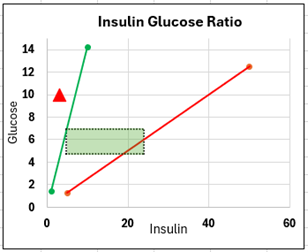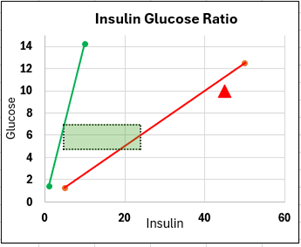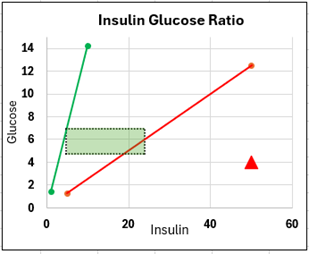Insulin Resistance
Panel
Insulin resistance impedes cells from utilizing glucose efficiently, leading to elevated blood sugar levels which contributes to diabetes, obesity, and other metabolic disorders. Manage these patients easier with the Insulin Resistance Panel.
Insulin Resistance Panel – Overview
Canine , Feline
The Insulin Resistance Panel aids in the management of diabetes and pre-diabetes in cats and dogs. Early detection and regular monitoring are vital for successful intervention whether using traditional or integrative approaches.
| Included Tests: | Insulin, Glucose Insulin-Glucose Ratio |
| Recommended Additional Tests: | Vitamin D Magnesium |
| Species: | Canine, Feline |
| Sample Type: | Serum – frozen |
| Volume Needed: | 0.5 mL |
| Fasting: | 8hr Minimum Fast |

Which pets should test?
- Senior animals
- Chronic or repeated Pancreatitis
- Obese animals
- Long-term steroid use
- Cushing’s disease
- Pets exhibiting signs of diabetes (see below)
Understanding the Insulin-Glucose Ratio (IGR)
Introduction
The insulin-glucose ratio (IGR) is a diagnostic tool used to assess the relationship between insulin and glucose levels in the blood. This ratio can provide valuable insights into insulin sensitivity and beta-cell function, which are crucial for understanding and managing diabetes in dogs and cats.
The insulin-glucose ratio (IGR) is calculated by dividing the fasting insulin concentration by the fasting glucose concentration. The formula is:
IGR = Fasting Glucose (mmol/L) / Fasting Insulin (μU/mL)
Significance of the Insulin-Glucose Ratio
- Early Detection of Insulin Resistance: An elevated IGR suggests that the pancreas is producing higher than normal levels of insulin to maintain normal blood glucose levels, indicating insulin resistance. This is often a precursor to type 2 diabetes.
- Beta-Cell Function Assessment: A low IGR might indicate beta-cell dysfunction, where the pancreas is unable to produce sufficient insulin, potentially leading to type 1 diabetes.
- Monitoring Pre-Diabetic States: Pets with a borderline or slightly elevated IGR can be monitored more closely for early signs of diabetes, allowing for early intervention with diet and lifestyle changes to prevent progression.
- Detection of Insulinomas: IGR may be useful in revealing an insulinoma. Further confirmation may be done with a VDI Cancer Panel and imaging.
Diabetes in Dogs
Diabetes mellitus in dogs is primarily characterized by an absolute deficiency of insulin, similar to Type 1 diabetes in humans. This condition is often caused by autoimmune destruction of the insulin-producing beta cells in the pancreas. Factors that contribute to diabetes in dogs include genetics, obesity, pancreatitis, and certain medications.
Role of IGR in Canine Diabetes:
In diabetic dogs, the IGR can be a useful tool for diagnosing and monitoring the disease. Typically, diabetic dogs will have low insulin levels relative to high glucose levels, resulting in a low IGR. Monitoring IGR can help in adjusting insulin therapy and managing the condition effectively.
Symptoms of Diabetes in Dogs:
- Increased thirst and urination
- Weight loss despite increased appetite
- Lethargy
- Cataracts
- Recurrent infections

Diabetes in Cats
Diabetes mellitus in cats is more commonly analogous to Type 2 diabetes in humans. It is often associated with insulin resistance and impaired insulin secretion. Risk factors for feline diabetes include obesity, physical inactivity, genetics, and certain medications.
Role of IGR in Feline Diabetes:
In cats, the IGR can help identify insulin resistance early. Cats with diabetes often exhibit high insulin levels relative to high glucose levels, resulting in a high IGR. This information can guide dietary and therapeutic interventions to improve insulin sensitivity and manage the disease.
Symptoms of Diabetes in Cats:
- Increased thirst and urination
- Weight loss despite increased appetite
- Lethargy
- Poor coat condition
- Plantigrade Stance (walking on the hocks)

Insulinoma
Insulinoma is a rare, typically malignant tumor of the pancreas that secretes excessive amounts of insulin. This condition can occur in both dogs and cats, though it is more commonly diagnosed in dogs. In insulinoma, excessive insulin secretion leads to hypoglycemia (low blood sugar levels).
Role of IGR in Insulinomas:
In animals with insulinoma, the IGR is significantly altered. Due to the excessive production of insulin, these animals will have very high insulin levels relative to low glucose levels, resulting in a very high IGR. The abnormal IGR in dogs with insulinoma serves as a critical diagnostic indicator. Alongside clinical symptoms of hypoglycemia, a high IGR, and a positive TK1 Cancer Panel, strongly implies insulinoma.
Symptoms of Insulinoma:
- Weakness
- Seizures
- Disorientation
- Collapse
- Weight gain (due to increased food intake driven by hypoglycemia)

Impact of Vitamin D and Magnesium
on Insulin and Glucose Management
Vitamin D
Vitamin D is known to play a role in glucose metabolism and insulin sensitivity. It exerts its effects through various mechanisms, including enhancing insulin receptor expression and improving beta-cell function in the pancreas.
Effects of Vitamin D on Insulin and Glucose Management:
- Insulin Sensitivity: Vitamin D enhances the expression of insulin receptors, improving the body’s sensitivity to insulin.
- Beta-Cell Function: It promotes the function of pancreatic beta cells, which are responsible for insulin production.
- Inflammation Reduction: Vitamin D has anti-inflammatory properties that can help reduce chronic inflammation, a risk factor for insulin resistance.
Studies have shown that Vitamin D deficiency is associated with an increased risk of developing diabetes and metabolic syndrome in both humans and animals. Supplementation of Vitamin D in diabetic animals has been observed to improve glycemic control and insulin sensitivity.
Magnesium
Magnesium is involved in numerous reactions in the body, including those related to glucose metabolism and insulin action. It acts as a cofactor for enzymes involved in carbohydrate metabolism and influences insulin secretion and activity.
Effects of Magnesium on Insulin and Glucose Management:
- Insulin Secretion: Magnesium is crucial for the secretion and action of insulin. It helps in the transportation of glucose into cells, where it can be utilized for energy.
- Insulin Sensitivity: Adequate levels of magnesium improve the body’s sensitivity to insulin, facilitating better glucose control.
- Glycemic Control: Magnesium supplementation has been shown to lower fasting blood glucose levels and improve overall glycemic control in diabetic patients.
Magnesium deficiency is commonly observed in individuals with diabetes, and supplementation can help in reducing insulin resistance and improving metabolic control.
Supplementation:
Supplementation with Vitamin D and Magnesium can be beneficial in managing diabetes. Ensuring adequate levels of these nutrients can improve insulin sensitivity, enhance beta-cell function, and provide better glycemic control.
